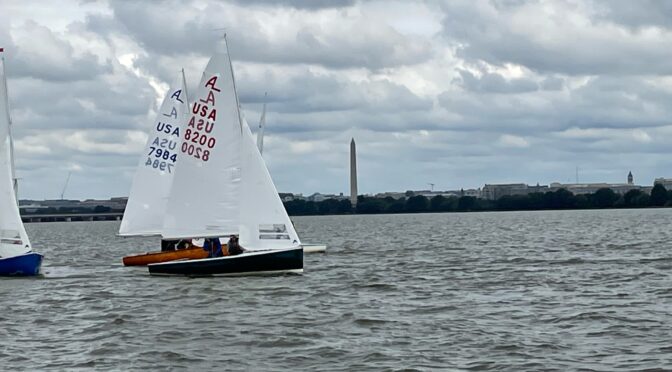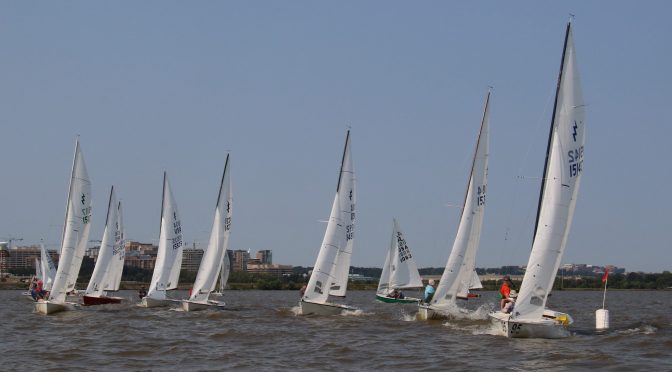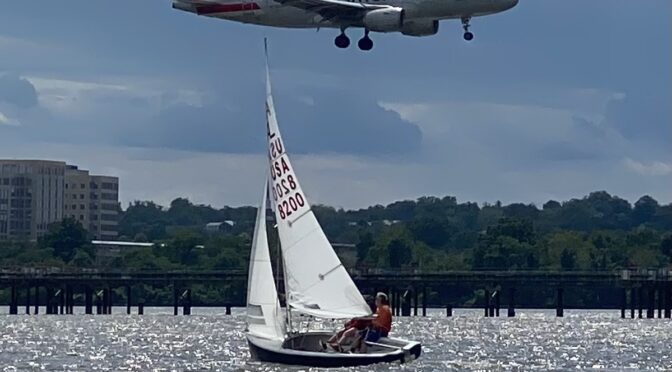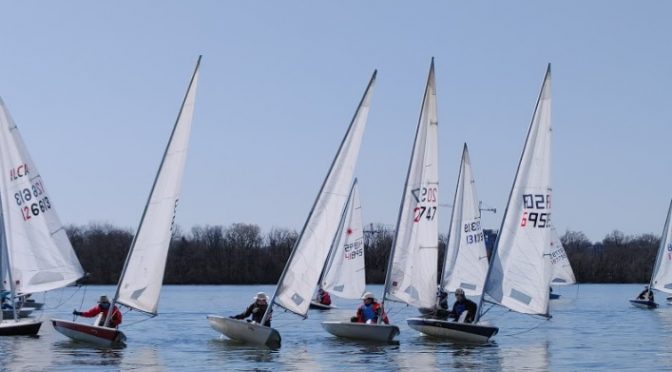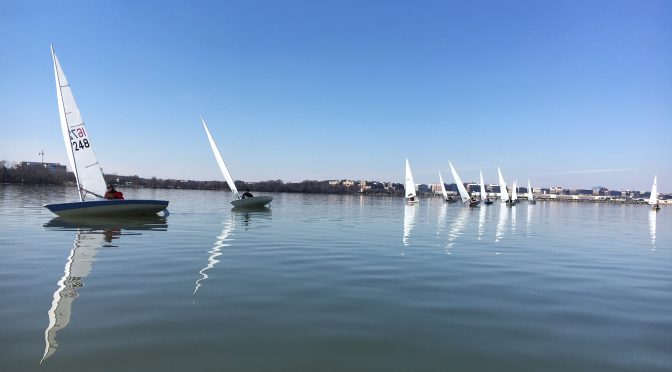All posts by Farley Will
2022 Presidents Cup Regatta – Register Now!
Join the Potomac River Sailing Association to race in the largest one-design regatta on the Potomac with the National Capitol and monuments as a backdrop, and to carry on the tradition of competitive one-design racing that started with the 1934 President’s Cup! All one-design classes 20 feet or under are invited.
PRSA Spring Regatta Writeup and Results
Another Win for the Red Boat at the PRSA Spring Regatta
By Steph Mah
A few weeks ago, Barney Harris made Raines an offer to come down and race in the Potomac River Sailing Association’s Spring Regatta. It was one of those offers Raines couldn’t refuse – Barney was providing his Republican red boat, his house, pick up and drop off from the airport, and a lot of beer. Raines asked me to tag along knowing that I wouldn’t be able to resist getting into political arguments with Barney and possibly wind up epoxied to a dock.
The forecast was for light air on Saturday and even less on Sunday – but if you didn’t want to hike (like me), this wasn’t a bad thing. Unfortunately, like pollsters, weather forecasters can be completely wrong with no consequences, and what we actually got on Saturday was a gusty 10-15 knots with a small craft warning in effect.
An albacore is an albacore is an albacore – unless it’s Barney’s, which has about 99% more control lines than what we’re used to. Writing down what some of the lines did was helpful, but that didn’t stop us from falling down a couple of times during tacks and gybes. It seemed like going left was the payoff move, but being Canadian and polite, we went right to stay out of everyone’s way. Eventually, with some skill (from Raines) and luck (being the ant infestation in the boat Barney was using), we got ourselves settled and Barney’s red boat squeaked out a bullet in the last race over Barney’s other boats,
giving us the lead for the day. Dinner was a huge spread of tacos, nachos, salads, cookies, and beer.
Sunday was one of those days where you discovered how cruel or kind the RC was. The wind was looking bleak (except for when the planes were landing), so the only decision was whether they would postpone us on land or make us go out. Fortunately, they went with the former, giving Barney more time to murder ants, and eventually they called the day off to the relief of many. And more tacos and nachos were served!
We got some very nice prizes, but the real champions of this regatta were the volunteers. I understand there was a four(!!!) person regatta committee with many more hands that pitched in to pick up the food, pack it away, set it back out, run the races, get the prizes, get the ice, and the list goes on and on. And it was an amazing event – there was a ton of good food, coolers full of Hapco-sponsored beer (that Raines orbited like a little moon), and lots of helpful and friendly people. It made me feel welcome and made me want to come back. I hope the volunteers all know how much the sailors appreciated the work (and plan to pay it back), and how proud PRSA should be of them.
Again, a huge thanks to everyone for their work on this regatta, and the biggest thanks to Barney for making this happen and for not watching us while we took 40 minutes to de-rig his boat.
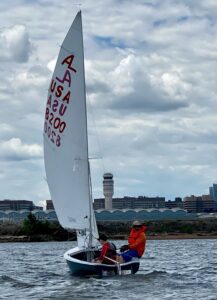
2022 AGM and Awards Update
On April 9th the fleet had an AGM and BBQ at the Washington Sailing Marina, Despite cooler temperatures it was a nice day and picnic. Eva Hogan was voted in as the new Fleet Captain and awards were presented!
2021 Awards:
Fleet Booster Award – Bob Bear
Freshman Booster Award – Tyler Phillips
Most Improved B Skipper Award – Eva Hogan
Jib Tender Award (Best Crew) – Kaitlyn Lucey, for getting Dan Miller’s boat out on the water all year and to some away regattas!
Most Abused Crew Award – Barney Harris
Six Deep (Capsize) Award – Nich Allen
2020-2021 LASER FROSTBITE SERIES #17
It’s Groundhog Day with another 3rd place write-up from me. Surely no frostbites today – sunburns were more likely. It was like a high school dance in winter with few participants appropriately dressed for the temperature, the venue not quite fit for purpose, yet everyone seemingly having a good time. We’re used to shifting winds on the Potomac, but today took it to a new level. It reminded me of Rumsfeld when he confidently said the WMDs were, “east, west, south and north somewhat.” Dan and Mike energetically boated around trying to have the marks in the right direction only to find that between the warning sound and the start not only might it change which end of the starting line was favorable, but which was the more logical windward mark. Big thanks to Dan and Mike for adding another great sailing day, and to Farley for delivering the attached results.
2020-2021 Laser Frostbite Series #15
Sunday was sunny, warmish, and probably the windiest frostbite day so far. John and Greg laid out an Olympic triangle course, which provided for planing when the gusts coincided with the reach legs. Greg and John heroically tried to adjust the course to the changing winds and were, on average, successful. Big thanks to John and Greg for RCing and to Farley for the attached results.
The starts were exciting – it was often possible to sail the length of the line in less than 20 seconds, so it quickly got crowded. I preferred shuttling between the pin and the boat and coming on port to find a good spot behind the RC boat about 35 seconds before the start. That way I avoided getting stuck in a crowd … it worked sometimes. Having, for once, the current largely in the same direction as the wind also made the typical strategy of lingering on the line viable.
On the upwind leg, gusts often came along with 30-40 degree wind shifts. That meant we had to be on our toes … or more literally ready to quickly adjust the sheet, rudder, and body position. The first victim I witnessed was Jim G., who had to tack as Farley came on starboard right at the time of a big gust and wind shift, which landed Jim with a taste of the Potomac.
Downwind was fun as there was just enough wind for a bit of waves to form. That allowed for practicing both following the waves and using body movement and sheeting to control the boat with minimal rudder. Supposedly s-turns on the downwind leg are more efficient, but I still haven’t figured them out. During stronger gusts, the jibing could also get exciting. At one point I was chasing Len for the first place he capsized right by the mark. I then managed to not only also capsize, but as I tried to climb around to the daggerboard I somehow tripped in a way that had me drop backward in the water hitting daggerboard on the way down before having my first taste of the Potomac. A far cry from the salty sea water I grew up with, but not as bad as feared. Glorious as my fail felt, had we had a weekly epic performance award, it would have probably gone to Tyler, who artfully lodged 8603 almost completely atop Celeste’s laser. Surely I missed many other exciting incidents – all in all, another beautiful Sunday on the Potomac.
Now, this is my 3rd 3rd place write-up, so I’d suggest we adjust to formula next season to include more authors. Not just because I’m lazy, but also for literary diversity and because I’m curious about others’ experiences and ideas.
Finally, happy International Women’s Day – it is truly a joy to have you dedicated, fearless, fun, and lovely women both on the water and on the dock – you represent the best of what IWD stands for!
2020-2021 Laser Frostbite Series #14
- Fuel. Keep the fuel tank above 1/2 full and ideally above 2/3 full. This prevents condensation, which prevents water in the fuel, which prevents the motor not working as what happened last week. There is no way to visually see water in the fuel; you know that watery fuel is likely the problem when the skiff won’t start. Thus, if it is your day and the fuel level is below 2/3 full (ish), go to the Shell station and fill up. There are gas tanks in the locker by the boat.
- Cover. Be sure the cover is on tight so that water does not pool and does not end up in the boat.
- Drain Plugs. There are three at the back of the boat. Make sure they are all in before launching.
- Motor up! There is a switch on the throttle that raises and lowers the engine; the engine MUST be up during trailering because it might hit something, especially the parking bumper in the trailer spot.
- Battery Switch. There is a switch in the big box at the back of the skiff that turns the battery on/off. This must be off at the end of the day.
- Head out of the boat (another reminder) – Sunday was one of those days when my position at any given point felt more tenuous than usual – if I was ahead, it could change easily, and if I was behind, especially at the first leeward rounding, there were often opportunities for catching up. Thus, it was a day that seemed to require a more than usual amount of paying attention to everything – other boats, how they were headed, the wind (which was patchy and not always easily visible on the water), and with the current, the location of the marks, especially the leeward mark. I didn’t do quite enough of this.
- Starts. The day started with a boat-favored line, which made things a bit crowded at the starboard end. To make things even more challenging, the current kept the committee boat facing upriver and perpendicular to the direction of the wind which meant that it was easier than usual to snag the anchor line due to both the orientation of the committee boat and the direction and magnitude of the current. One race I got snagged on the anchor line (note to self!). In the later races, I had decent luck starting further down the generous line and catching what seemed to be more wind/more favorable shifts on the left side of the course.
- Leeward Leg. Downwind legs tended to be very slow. Going high(ish) generally helped, but I had luck going a bit lower during some of the earlier races. Sometimes it was a regular downwind and sometimes it was more of a reach, even on the same leg! At one point I, like many others, had to approach close-hauled just to get to the leeward mark due to the wind mostly dying and having to battle the current. Fun times.
Additional comment. Thank you to those of you who were really good about yelling starboard and/or communicating about whether I could keep going or not. Let’s keep that communication up! Not just on windward legs, but noting overlaps (or not) at mark roundings too. It really helps.
2020-2021 Laser Frostbite Series #13
This week Tom got 3rd place. But since he volunteered to head in early and get the 19 to tow in the 17 (due to engine issues), I decided that I would do a 1st place write up to mix it up.
2020-2021 Laser Frostbite Series #9
So we had a forecast on sunday of 5-10 from the NW shifting to SW sometime after noon. What with the lay of the land and the obnoxiousness of the front, we pretty much had both at the same time. It never filled in fully from the SW, but we had consistent oscillations to the west all day, and that was also where the pressure was better. So staying west generally paid off.
For most of the starts the line was square at some point in the sequence, but we got a lot of last minute westerly shifts which favored the port end. So I managed to get a couple really nice port tack starts. The current was around, but it never seemed to be a big deal this weekend.
At the start and on the first beat, when I had clear air I did well, and when I did not, it was awful. In the light conditions I found that disturbed air from boats to weather extend 6 or 8 boat lengths downwind. I think I paid more attention to clear air than even to the shifts. On the other hand, the shifts were big enough, and the course short enough, that tacking right away on the 10+ degree shifts made a big difference.
Finally, this was my best performance of the season, and I still placed third! I am still figuring out the leeward legs and the last mark rounding clearly has it in for me.
2020-2021 Laser Frostbite Series #7
Dear fellow frostbiters!

